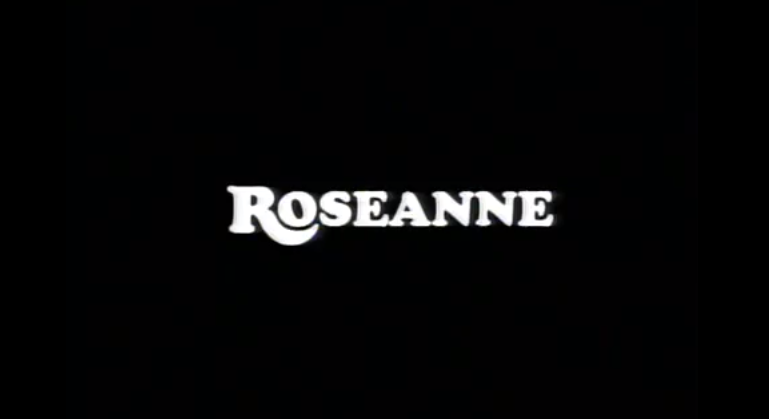
Introduction
The television sitcom Roseanne (1988-1997), led by Roseanne, popularized the trend of stand-up comedians leading sitcoms based on their routines – Seinfeld (1989-1998) for Jerry Seinfeld, Home Improvement (1991-1999) for Tim Allen, and Ellen (1994-1998) for Ellen DeGeneres. The series focuses on Roseanne Conner, an overweight, brash mother of three children – Becky, a stereotypical teen girl; Darlene, a sarcastic tomboy; and D.J., a peculiar young boy – and wife of contractor Dan Conner. Despite the series’ feminist discourse – mostly in the hands of its title character and actress – Jeremy G. Butler argues that Roseanne fails to fight the patriarchy because she is a mother and wife whom the audience sees as existing within the framework of patriarchal society (17). However, Butler’s argument suggests a rigid definition of feminism – a dangerous way of looking at the ideology if there ever was one – that a devoted wife and committed mother is inherently not a feminist. The concepts of television literacy and hypermediacy frame the body rhetoric of Roseanne in Roseanne as she subverts stereotypical expectations of the leading female actor and women in general and winks at her audience while promoting social progressivism and rejecting sexism and racism.
The Sitcom as Text: Understanding Television Literacy and Hypermediacy
Television Literacy
In his discussion of television literacy, Harold M. Foster says “theme, character, plot, and style,” elements of literature, are important to consider when acquiring television literacy (70). He also lists film and television’s structural elements, which include “editing, movement, composition, color, lighting, and sound,” and states how people use these elements to stir the audience’s emotions and beliefs (71). Foster argues that: editing can fool people into thinking talentless basketball players are professionals; quick motions create excitement, while slow movements signify strength; composition, or arrangement, can create feelings of isolation or importance; vivid colors instill a sense of fun and pleasure; colorless cinematography has little effect on viewers, while light can set moods of happiness or sadness, such as in commercials for various medicines; and music cues can instill terror, while “thwacks” indicate physical violence (71). Foster’s brief examples of film and television’s structural elements, however, underestimate the impact these elements can have on an audience. Editing can be used not only for comedy and drama within a scene but also to juxtapose different storylines with one another. Arrangement can also refer to character introductions or how series introduce characters to particular scenes or scenarios. Color or the lack thereof can reflect a certain time period in addition to highlighting particular moods. Music can set moods in the same way that color can, too.
Hypermediacy
Though films and television series feature identical structural elements in Foster’s argument, the size of the screens on which we watch both is not the only difference between film and television, as hypermediacy also separates the mediums from one another. Jay David Bolter and Richard Grusin coined the term “hypermediacy” in Remediation: Understanding New Media and define it as “[a] style of visual representation whose goal is to remind the viewer of the medium” as opposed to being transparent (272). In other words, hypermediacy is the quality of a media text that points out its status as a media text. Similar to “breaking the fourth wall,” this allows for a text to wink at and acknowledge its audience in ways that come across as awkward or out of place for media texts that attempt to achieve transparent immediacy.
Television calls attention to itself even if the given program tries to achieve transparent immediacy, while films by nature achieve transparent immediacy. Logos take residence in the bottom right corner of the television screen, though they do not adorn films shown at a movie theater. Each episode of a television series must fill a specific amount of airtime (usually 30 or 60 minutes) in tandem with commercials – unlike a film, which is not restricted to any specific number of minutes; films are sequences of uninterrupted scenes, but unless it airs on one of the cable networks such as HBO, an episode of a television series must space out its happenings in intervals appropriate for these commercial breaks. Stills of the given setting in a series often follow a commercial break and indicate a passage of time and the beginning of a new scene.
The sitcom achieves hypermediacy more so than the drama, however, because it constantly calls attention to itself. The use of audience laughter – the laugh track in more modern sitcoms – helps the sitcom achieve hypermediacy. Actors pause as the audience (or “audience”) laughs at the humorous situations, dialogue, and/or facial expressions. The audience tuning in at home can hear this laughter several times each minute; episodes and scenes with a more dramatic tone make less use of audience laughter. The audience might also applaud a character’s respectable actions, clap alongside an especially humorous moment, or make an ominous “Ooh” sound if a character does or says something perceived as cruel or offensive. The actors might pause or refrain from scripted actions or dialogue to wait for a laughing or applauding audience to silence itself. The television sitcom also achieves hypermediacy through its limits. Sitcoms make significant use of one or two locations and mostly exclude other locations. For instance, we see the Conner’s living room in almost every episode of Roseanne, but we always see the room from the same angle. Perhaps as a wink at the audience – a “mirror image” of us, even – the television screen is always absent from our view. This calls attention to television as a medium because of the television’s lack of visual presence despite our knowledge of its presence.
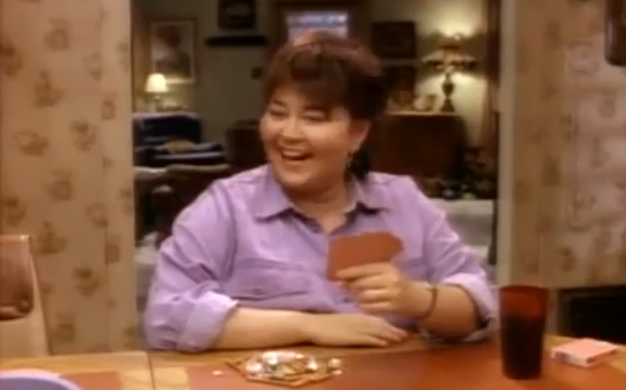
Roseanne as a Rhetor
Body Rhetoric
Roseanne’s body rhetoric frames her arguments for social progressivism even when she does not directly make such arguments. Jason Del Gandio describes body rhetoric as a human body itself paving the way for rhetorical communication (145). He examines embodied argumentation, our physical actions making arguments; street theatre, such as rallies and protests; rhetorical style, the mood set by gestures we make; and bodily emanation, what bodily vibes themselves suggest (145-146). Roseanne most readily expresses embodied argumentation because of her frame and voice. Embodied argumentation calls to action, allows for non-verbal rhetoric, empowers, and boasts about the everyday (Del Gandio 146). The body, the message, and the audience are three primary aspects of embodied argumentation (147). The body makes your argument; others take in your argument, which should be tailored to the audiences’ needs (147-148).
Roseanne proves that loving wives and mothers can be progressive and feminist with the body rhetoric captured on her sitcom. She defies the patriarchy’s rigid definition of femininity, which Christina Fisanick describes as an ideological system – not an inherent quality one possesses – that restricts its female participants to be defined by their physical characteristics (106). Women participating in this view of femininity keep “fit,” shave or wax, and get rid of perceived physical blemishes (106-107). Roseanne held a place in the cultural conversation many “fat, loud-mouthed feminists” could not (Ehrenreich 367). Roseanne remains a full-figured woman (despite losing weight throughout the course of the series) and resists what society says she should be. She challenges traditional views of femininity by simply existing on the screen, and challenges how we view the leading sitcom actress by simply leading Roseanne; she also subverts the character type of the shrew, the loud and unruly woman who does not willingly submit to her husband, and consequently disrupts the patriarchy by also stepping into the role of the domestic mother in the sitcom. Roseanne’s body serves as the argument against societal norms about women, and she tailors her argument to the audiences’ needs by adopting the sitcom format.
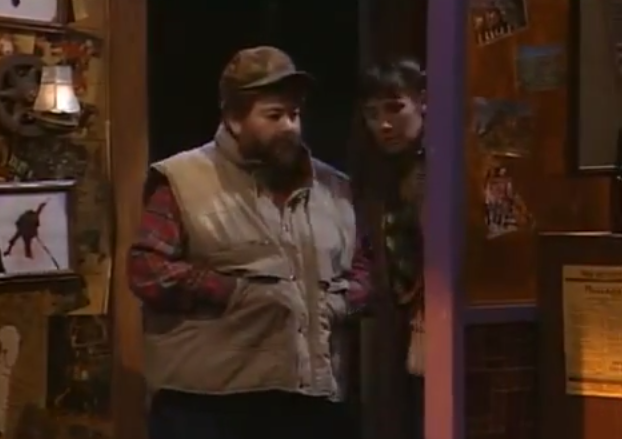
If She Were a Boy: Gender Performance in “Trick or Treat”
The Roseanne episode “Trick or Treat” (1990) manipulates the Halloween tradition of donning costumes, the sitcom’s juxtaposition of multiple plots, and hypermediacy to examine sexist attitudes about gender performance. This episode centers on two characters’ chosen Halloween costumes: Roseanne as a man and D.J. as a witch; the former explicitly sets up the scenario of gender as performance. Roseanne and her sister Jackie are stuck at the Lobo Lounge, a regular hangout of the series’ adult characters, on Halloween night. The first shot of this scene displays Jackie – not Roseanne – inside the lounge as she urges her reluctant sister to come inside. We have no idea of Roseanne’s chosen costume before she walks through the doorway, but audience laughter and applause follow her entrance into the frame as she reveals her Halloween costume: a man with facial hair wearing a plaid shirt, vest, and baseball cap. Roseanne explicitly points out gender as performance through her costuming. She already does not subscribe to traditional notions of femininity throughout the series, but her Halloween disguise allows her to perform outside of normative femininity with less societal consequences. Roseanne emphasizes the performance of gender through her behaviors in five different scenarios: sitting at the bar, talking with men playing pool, using the Lobo Lounge’s male restroom, talking with one of her friends, and getting into a fight to protect her friend; her gendered performance provides much of the humor in the episode.
While sitting at the bar, Roseanne as “Bob” lowers her voice and engages with the bartender in rhetoric that demeans women, asking about “the action in here” and “chicks” and complaining that it must be that “time of the month” for Jackie, her “squeezebox.” The bartender, however, does not know the true identity of Bob and speaks with Roseanne as he would speak with a man. Jackie buries her head in laughter and embarrassment; she represents us, as we, the audience on the outside, are also in on the joke. Roseanne’s performance and the format of the sitcom subvert this conversation into a commentary on this speech and not a defense or endorsement of it. Roseanne then walks over to a pool table and listens to a man talk about a sexual experience. She mocks him and accuses him of lying, and only says “OK” when he asks if she is joking. A trip to the men’s restroom becomes awkward for Roseanne as she tries to discuss sports with another person in the restroom. Roseanne says, “Oh, I get it. It’s like being in an elevator,” at the end of this scene. She returns to the bar upon seeing Crystal, one of her friends. Roseanne tells her that she needs to start respecting herself. The audience roars as Crystal flirts with Bob; Roseanne’s disguise prohibits her from her usual female camaraderie. The man who earlier told stories about his sexual encounters harasses Crystal, but Roseanne tries to defend her.
Dan appears in this final scene of “Trick or Treat,” and his behavior ties into the dilemma that involves D.J.’s aforementioned costume choice. At the beginning of the episode, D.J. shows his witch costume to Roseanne and Jackie. Roseanne feigns fright at the sight of a witch; Jackie compliments his outfit. Dan, however, expresses legitimate fear, asking Roseanne, “What, two daughters isn’t enough for you?” He tries to convince D.J. to say he is a warlock, even though he had no problem with Darlene dressing as a pirate in years past. A girl can dress as a boy, but a boy cannot dress as a girl. The performance of gender preoccupies Dan’s thoughts, but D.J. does not see being a witch as gender performance. Still, Dan cannot get past his rigid views of gender even after Roseanne rebukes his views. “Trick or Treat” focuses on Dan and his problems with D.J.’s costuming when the episode takes the focus away from Roseanne’s drag performance. He talks with a friend about this being “just a phase,” perceiving D.J.’s performance of the female gender as a denial of heterosexuality. His friend tells him that you cannot change this one way or the other, and that the perceived gender performance is more important to Dan than it is to D.J.
Dan’s behavior in the final scene of “Trick or Treat” plays on what we know about him and Bob to showcase his evolved views on gender as performance. Crystal’s harasser is about to fight Bob as Dan arrives at the Lobo Lounge. He steps into the altercation and tells the harasser that Bob is his husband. The knowing audience interprets this as humorous because he is a heterosexual man saying that his wife, in a temporary gender performance as man, is his husband. His views on gender performance have evolved. He even plays on his previous prejudices – rigid views on gender performance – to scare the homophobic harasser, who then flees the scene. Roseanne and Dan then embrace and kiss. Dan spits out some of Roseanne’s fake facial hair and remarks that her beard tickles. Audience laughter and applause concludes the episode as Dan shows no shame in embracing Roseanne as she performs as Bob.
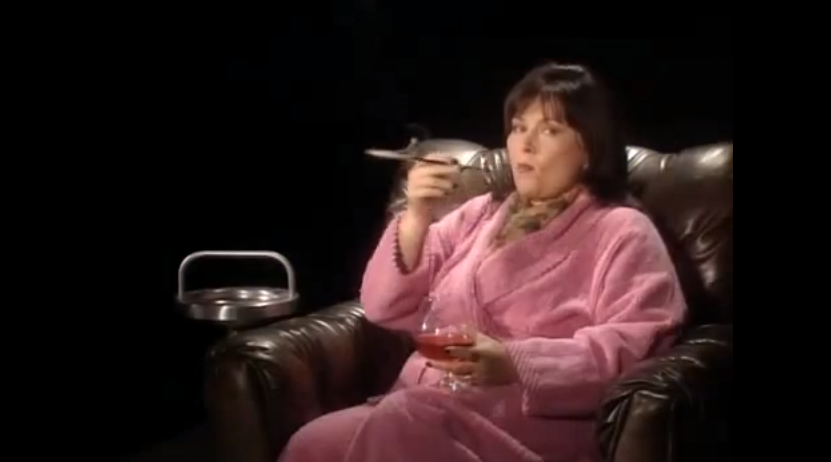
That’s Our Rosey: Misogyny and Racism in “The Fifties Show”
“The Fifties Show” (1995) plays on hypermediacy to make its audience aware of the episode’s own uniqueness through its introduction, and recalls the white- and middle-class-centric sitcoms of the 1950s not for the simple sake of parody but to make progressive statements about women and black people and consequently denounce the sexism and racism of the 1950s – both in the media and in society as a whole – throughout the remainder of the episode. As “Rosey,” Roseanne speaks of her son catching “that pop beat fever,” but the episode ridicules more about 1950s America than its slang. White families who occupied the middle class overtook television sitcoms in the mid-1950s and dominated the format through the late-1960s; advertisers needed the middle-class environment to promote their products (Press 141). This made for less diverse representation: (white) women were housewives; their (white) husbands and the fathers of their children were the breadwinners; and series integrated so-called (white) family values into their programming without winking at their audiences (141).
The introduction to “The Fifties Show” suggests that we will not see a usual – or “canon” – episode of Roseanne. The episode begins with the series’ jazz-influenced theme music but eschews the series’ usual opening sequence. Instead, the shot gives way to Roseanne, dressed in a pink nightgown, sitting in a leather chair as she smokes from a cigarette holder and holds a glass of wine. She introduces herself as “Roseanne Barr Pentland Arnold Thomas or, as I like to call me, Roseanne” with a faux upper-class accent. Audience laughter and applause follow both chosen names. Roseanne then describes the original pilot of the series from 40 years ago that was recently found.
This introduction, however simple it might be, accomplishes an important task with one long take of Roseanne. She describes what we are about to see, embodying hypermediacy more than the series normally does. Her pink nightgown, cigarette holder, and wine glass and the leather chair in which she sits signify a certain status, one far different from the blue-collar Roseanne we see throughout the series. The surnames she lists highlight her real-life marriages, not her marriage in the series to Dan. Roseanne, through words and attire, makes it known that Roseanne the actress, not Roseanne the blue-collar mother, introduces this episode and calls to our attention that we will see a scripted set of events.
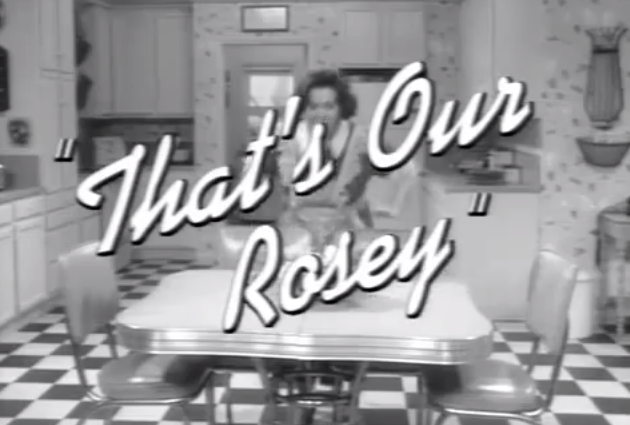
Black-and-white then frames “The Fifties Show” as a visit to the past. The screen fades and gives way to a black-and-white shot of a kitchen as Roseanne walks in from the back. Foster argues that black-and-white has little effect on television viewers, but in this particular instance, it refers to a different time period as do the furniture and appliances in the kitchen and Roseanne’s attire. The cinematography might not stir the emotions of the audience, but it signals that we are watching Roseanne and her family in a different time period. The actress’s mere presence in this “pilot” from the 1950s makes more evident the body rhetoric in which she already participates throughout the series. She wears an apron over a dress, an outfit typical of mothers seen in 1950s television series. An announcer whose voice resembles those of older sitcoms (read: heterosexual white male) tells us that we will see an episode of That’s Our Rosey as Roseanne places a bowl of artificial fruit on the table in front of her. The announcer then introduces her as “America’s favorite housewife.” Butler says Roseanne only exists as a housewife, but only here does the actress limit herself and her character to being “just” a housewife. The camera then cuts to a close-up of the actress as she smiles.
As one might predict, “The Fifties Show” alters other significant aspects of the series. Characters remain, though they take on different roles. For instance, Dan is an accountant with limited views on women, and Jackie is Rosey’s wacky neighbor and not her sister. Also, a shot of the Conner residence follows the introduction. Establishing shots in Roseanne typically examine the exterior of the household from multiple angles; music similar to the theme music usually accompanies them. However, in “The Fifties Show,” music stereotypical of the 1950s sitcom accompanies this single shot of the house. The interior of the Conner household also appears more upper class than the interior of their household in usual episodes. The Conners of That’s Our Rosey have luxuries; the Conners of Roseanne barely get by.
“The Fifties Show” first examines sexist attitudes by using the “fast-forward” technique typical of comedic entertainment to make a statement about women. Dan talks several times in the episode about how he needs to work on “that darned Anderson account.” Rosey always assures him that he can get it done. Dan and Rosey have this kind of exchange once while in his home office. He leaves the room, sure that he will never figure out the account. Rosey then sits at his desk and crunches numbers on a calculator to finish the Anderson account; “fast-forwarding” ensures that she did so without straining herself. The editing in this scene makes heavy use of hypermediacy as we know that Rosey could not have literally finished the Anderson account at lightning speed. However, this editing makes evident how Rosey breezes through what this sitcom sees as a man’s work and also makes us laugh at the patriarchal norms perpetuated by sitcoms of this time period.
The following scenes tackle racism of 1950s television, the first involving an interaction between Rosey and Mose, a black man. In working-class attire, he comes to the Conner residence with his son, unnamed at the time, and speaks in exaggerated manners stereotypical of black individuals in the media of the 1950s – he jocosely says, “E’nin” and “choich” in the place of “Evening” and “church,” for instance. Robin R. Means Coleman discusses TV Minstrelsy as a period from 1950 to 1953 in which black individuals and culture were portrayed as unequal and subservient to white individuals and culture, normalizing the latter and making the former deviant (86). This scene points out TV Minstrelsy, and the lack of audience reactions for these first few moments makes for a noticeable void in this format known for several accounts of audience laughter each minute. These moments serve as an uncomfortable reminder of the racism that society and media perpetuated in this time period. Roseanne does not allow her viewers to simply remain uncomfortable and feel pity; she insists on directly pointing out the inequalities in an ironic way that makes them laugh at this society. She asks how people on Mose’s side of town are doing, to which he responds that they happily work all the time. Audience laughter follows both Rosey’s question and Mose’s answer, suggesting a ridicule of both the denial of inequality based on the “separate but equal” mindset and the media’s idealistic portrayals of racial inequality in the past.
The next scene further highlights the racial inequality perpetuated by the media. Mose’s son asks whether things will change upon exiting the Conner residence. Mose says that things will indeed change and that his son might become president one day. However, he does this without the exaggerated TV Minstrelsy that marked his interactions with Rosey. Mose’s dropping of the minstrelsy façade after he has left the presence of white people showcases that the media of this time period only depicted black people in relation to white people. His verbal rhetoric changes, forcing the audience to further acknowledge the racial inequality of the past that still unsettles. The following scene, which returns us to the interior of the Conner residence, offers a refreshing twist. Becky asks Rosey who was at the door as she wears an expression of fear. She places her hand on Becky’s shoulder and responds, “Oh, that’s just old Mose Powell and his son, Colin.” This dialogue implies that the child is Colin Powell, who had been the first and only black person on the Joint Chiefs of Staff at the time of this episode’s premiere (“Colin”). The audience excitedly laughs at and applauds Rosey’s line.
The following scene uses a conversation between Rosey and Jackie to bring feminism into the discourse of “The Fifties Show.” While sitting in the kitchen, Rosey tells Jackie about a conflict she has with Dan about their son playing rock and roll. This leads into a discussion of how she never receives credit for the work she does as a housewife and concludes with her admitting that she is not happy. Jackie assumes a serious face and tone and closes the window blinds and doors to isolate her and Rosey in the kitchen. She then tells Rosey that other women feel similarly about their domestic situation and the patriarchy in general. Jackie subverts the kitchen, a symbol of domesticity in this time period, to become a woman’s place of conversation. She also reveals that she feigns “wackiness” to hide from others her feminist beliefs. Audience applause and laughter approve of Jackie’s dialogue throughout – especially when she speaks of the “Tupperware parties” that allowed women a special agency in the 1950s. Triumphant music plays in the background as Rosey slowly raises her fist into the air, a symbol that she will no longer submit herself to the rules set by the patriarchy.
Conclusion
Roseanne followed a long tradition of trailblazing female-led sitcoms like The Mary Tyler Moore Show and That Girl, but it presented a new image of the female lead – a woman who resisted patriarchal norms even while stepping into the role of wife and mother (Press 145). The series uses the conventions of television and plays on the hypermediacy of the format to make progressive statements about gender/sexuality and race. Roseanne as the rhetor argues for her causes simply by existing as the female lead and playing a loving wife and mother despite not fitting society or media’s molds for how a loving wife and mother should look and behave. She not only exists as argument, she also argues for these progressive values throughout the series. The camera captures Roseanne’s body rhetoric and utilizes her arguments for laughter from the series’ audience. “Trick or Treat” juxtaposes two stories to make a statement about gender performance, allowing Roseanne, in her disguise, to step into and subvert the patriarchy. “The Fifties Show” exaggerates the tropes of the white, patriarchal 1950s sitcom to examine that sociopolitical climate with a wink at the audience. Roseanne brings into sociopolitical discussion humor and makes its audience laugh at societal norms and rebuke societal prejudices through its manipulation of sitcom tradition and hypermediacy.
Works Cited
Bolter, Jay David, and Richard Grusin. Remediation: Understanding New Media. Cambridge: The MIT Press, 2000. Print.
Butler, Jeremy G. “Redesigning Discourse: Feminism, the Sitcom, and Designing Women.”Journal of Film and Video 45.1 (1993): 13-26. Web. 24 Sept. 2013.
Coleman, Robin R. Means. African American Viewers and the Black Situation Comedy: Situating Racial Humor. London: Routledge, 1998. Web. 4 Dec. 2013.
“Colin Powell.” Bio. A+E Television Networks, LLC, n.d. Web. 4 Dec. 2013.
Del Gandio, Jason. Rhetoric for Radicals: A Handbook for 21st Century Activists. Gabriola Island, Canada: New Society Publishers, 2008. Web. 4 Dec. 2013.
Ehrenreich, Barbara. “The Wretched of the Hearth: The Undainty Feminism of Roseanne Arnold.” Popular Culture: An Introductory Text. Eds. John G. Nachbar and Kevin Lausé. London: Bowling Green State University Popular Press, 1992. 366-373. Web. 3 Dec. 2013.
“The Fifties Show” Roseanne: The Complete Eighth Season. Dir. Gail Mancuso. Mill Creek Entertainment, 2013. DVD.
Fisanick, Christina. “Fatness (In)visible: Polycistic Ovarian Syndrome and the Rhetoric of Normative Femininity.” The Fat Studies Reader. Eds. Esther Rothblum and Sondra Solovay. New York: New York University Press, 2009. 106-109. Web. 3 Dec. 2013.
Foster, Harold M. “Electronic Media: Teaching Television Literacy.” The English Journal 70.8 (1981): 70-72. Web. 8 Oct. 2013.
Press, Andrea. “Gender and Family in Televisions Golden Age and Beyond.” Annals of the American Family Academy of Political and Social Science 625 (2009): 139-150. Web. 3 Dec. 2013.
“Trick or Treat.” Roseanne: The Complete Third Season. Dir. John Whitesell. Mill Creek Entertainment, 2012. DVD.